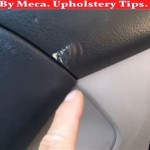Best Way To Remove Mold From Car Interior
Mold in a car interior is not just unsightly; it poses a health risk and can damage the vehicle's materials. Effective mold removal requires a thorough approach that addresses both the visible mold and its underlying causes.
Identifying the source of the moisture problem is the first crucial step. Mold thrives in damp environments. Common culprits include leaking windows, sunroof seals, or a clogged air conditioning drain. Addressing these issues prevents recurring mold growth after cleaning.
Safety precautions are essential before commencing mold removal. Protective gear, including gloves, a mask, and eye protection, should be worn to prevent exposure to mold spores. Adequate ventilation is also vital, preferably by working outdoors or with all car doors and windows open. In cases of severe mold infestation, professional remediation may be necessary.
Several cleaning solutions are effective against car interior mold. A solution of white vinegar and water is a natural and readily available option. A mixture of one part vinegar to one part water in a spray bottle can be applied directly to the affected areas. Allowing the solution to dwell for about 30 minutes helps to break down the mold.
Commercial mold and mildew cleaners are also available and can be highly effective. Always follow the manufacturer's instructions carefully. Bleach is often suggested for mold removal, but it should be used with extreme caution in a car interior. It can damage delicate surfaces and fabrics, and its fumes can be harmful. Diluted bleach solutions can be used on non-porous surfaces like hard plastics but should never be mixed with ammonia, as this creates toxic fumes.
After applying the chosen cleaning solution, thorough scrubbing is necessary to remove the mold. A stiff-bristled brush, an old toothbrush, or a detailing brush can effectively dislodge mold from various surfaces. For fabric upholstery, a specialized upholstery cleaner or a steam cleaner might be required for deeper penetration and effective removal.
Following scrubbing, the cleaned area must be thoroughly dried to prevent mold regrowth. Towels can absorb excess moisture, while leaving the car doors and windows open allows for air circulation and further drying. A dehumidifier can expedite the drying process, especially in humid climates. Direct sunlight can also assist in drying and naturally disinfecting the interior.
Leather car interiors require a slightly different approach. Specific leather cleaners and conditioners are recommended to avoid damage. After cleaning with a leather-appropriate solution, conditioning the leather helps restore its moisture and prevent cracking.
The car's ventilation system can harbor mold spores, necessitating specific cleaning. Specialized vent and duct cleaning products are available. These products often involve spraying a foam cleaner into the vents, allowing it to dwell, and then running the air conditioning system to circulate the cleaner and remove mold and debris.
Preventing future mold growth involves maintaining a dry car interior. Regularly checking for leaks and addressing them promptly is crucial. Parking in shaded areas can reduce moisture buildup. Using a car cover can protect against rain and dew. Promptly cleaning up spills and drying the affected area can also prevent mold from taking hold.
Fabric and upholstery treatments are available that can inhibit future mold growth. These treatments create a protective barrier on the fabric, making it more resistant to mold and mildew. They are particularly beneficial for areas prone to moisture, such as floor mats and seat upholstery.
Ozone generators are sometimes used for mold remediation, though they require careful consideration. Ozone is a powerful oxidizer that can effectively kill mold spores. However, it requires the car to be vacated during treatment and thorough ventilation afterward due to its potential health effects.
Professional mold remediation services are an option for severe infestations or when DIY methods prove insufficient. Professionals possess specialized equipment and expertise to handle large-scale mold removal and ensure complete eradication.
Regular inspection and cleaning of the car interior are essential for preventing and addressing mold growth. Maintaining a dry interior, addressing leaks promptly, and using preventative treatments are vital for a healthy and mold-free car environment.
Discarding heavily mold-infested materials, such as carpets or seat cushions, might be necessary in some cases. Professional advice should be sought when determining the extent of damage and the need for replacement.

How To Remove Car Interior Mold Auto Detail Doctor

Mold In Car How To Remove Your Puroclean Hq

How To Remove Car Interior Mold Auto Detail Doctor

How To Clean Mold In A Car Naturally Get Green Be Well

How To Remove Car Interior Mold Auto Detail Doctor

How To Remove Car Interior Mold Auto Detail Doctor

Getting Rid Of Terrible Mold In My Car With White Vinegar

Mold In Car How To Remove Your Puroclean Hq

How To Get Mold Out Of Car Interior And Carpet

How To Remove Car Interior Mold Auto Detail Doctor
Related Posts








